Penzance: Difference between revisions
m clean up, typos fixed: ealier → earlier, long standing → long-standing, fifteen mile → fifteen-mile |
|||
| (One intermediate revision by one other user not shown) | |||
| Line 71: | Line 71: | ||
==Around the town== | ==Around the town== | ||
Roads and paths lead out from Penzance. It is a fifteen mile walk to [[Lands End]] around the coast path. Nearer to hand, the pretty fishing port of [[Newlyn]] is to the south, now contiguous with Penzance, and around the cliff is [[Mousehole]] from which paths lead up and over the hills. [[Madron]], the little village from whose parish Penzance grew, is two miles to the north. | Roads and paths lead out from Penzance. It is a fifteen-mile walk to [[Lands End]] around the coast path. Nearer to hand, the pretty fishing port of [[Newlyn]] is to the south, now contiguous with Penzance, and around the cliff is [[Mousehole]] from which paths lead up and over the hills. [[Madron]], the little village from whose parish Penzance grew, is two miles to the north. | ||
[[Marazion]] lies on the other end of Mounts Bay, punctuated by the tidal island of [[St Michael's Mount]]. | [[Marazion]] lies on the other end of Mounts Bay, punctuated by the tidal island of [[St Michael's Mount]]. | ||
| Line 81: | Line 81: | ||
Evidence of historical settlement from this period can be found in the St Clare area of the town, where a chapel not unlike St Anthony's existed dedicated to St Clare or Cleer. Throughout the period before Penzance gained borough status in 1614 the village and surrounding areas fell within the control of the Manor of Alverton and was subject to the taxes levied by that manor. | Evidence of historical settlement from this period can be found in the St Clare area of the town, where a chapel not unlike St Anthony's existed dedicated to St Clare or Cleer. Throughout the period before Penzance gained borough status in 1614 the village and surrounding areas fell within the control of the Manor of Alverton and was subject to the taxes levied by that manor. | ||
The first historical mention of Penzance was in 1322 in local manorial records where it is given as a place for landing fish.<ref>Extent of the property held by the Manor of Alverton and accounts transcribed by Mr Paul Brand from the original held in the National Archives</ref> Until the 17th century Penzance was overshadowed by its near-neighbour [[Marazion]]. Marazion was recorded in the [[Domesday Book]] of 1086 while Penzance is not, and Marazion received its charter much | The first historical mention of Penzance was in 1322 in local manorial records where it is given as a place for landing fish.<ref>Extent of the property held by the Manor of Alverton and accounts transcribed by Mr Paul Brand from the original held in the National Archives</ref> Until the 17th century Penzance was overshadowed by its near-neighbour [[Marazion]]. Marazion was recorded in the [[Domesday Book]] of 1086 while Penzance is not, and Marazion received its charter much earlier, for King Henry III in 1257. In mediaeval times and later, Penzance was subject to frequent raiding by "Turkish pirates", in fact Barbary Corsairs.<ref>Canon Diggens Archive 1910</ref> | ||
In 1404 King Henry IV granted to Thomas Lord Berkley the right to hold a market in Penzance. This was the first seed of the town's growth. | In 1404 King Henry IV granted to Thomas Lord Berkley the right to hold a market in Penzance. This was the first seed of the town's growth. | ||
| Line 146: | Line 146: | ||
Every June since 1991, the Golowan Festival (which includes Mazey Day) has been held in the town. | Every June since 1991, the Golowan Festival (which includes Mazey Day) has been held in the town. | ||
Before the 1930s Penzance was the scene of large May Day celebrations, which saw local children making and using tin 'May horns' and 'May whistles'; a small revival of these traditions took place by design on 4 May 2008. The Feast Day of Corpus Christi was also celebrated in Penzance. The Corpus Christi fair has been a long standing event in the town, and is currently undergoing attempts to revive it in a more traditional format. | Before the 1930s Penzance was the scene of large May Day celebrations, which saw local children making and using tin 'May horns' and 'May whistles'; a small revival of these traditions took place by design on 4 May 2008. The Feast Day of Corpus Christi was also celebrated in Penzance. The Corpus Christi fair has been a long-standing event in the town, and is currently undergoing attempts to revive it in a more traditional format. | ||
Allantide, a Cornish version of Halloween, was also a popular activity in the town. Many of these customs were recorded by local antiquarian Margaret Ann Courtney and have influenced historical views of traditional Cornish cultural activities. | Allantide, a Cornish version of Halloween, was also a popular activity in the town. Many of these customs were recorded by local antiquarian Margaret Ann Courtney and have influenced historical views of traditional Cornish cultural activities. | ||
| Line 170: | Line 170: | ||
* [http://crocat.cornwall.gov.uk/dserve/dserve.exe?dsqIni=Dserve.ini&dsqApp=Archive&dsqDb=Catalog&dsqCmd=Overview.tcl&dsqSearch=((text)='penzance') Cornwall Record Office Online Catalogue for Penzance] | * [http://crocat.cornwall.gov.uk/dserve/dserve.exe?dsqIni=Dserve.ini&dsqApp=Archive&dsqDb=Catalog&dsqCmd=Overview.tcl&dsqSearch=((text)='penzance') Cornwall Record Office Online Catalogue for Penzance] | ||
*[http://mountsbaygigclub.org/ Mount's Bay Pilot Gig Rowing Club] | *[http://mountsbaygigclub.org/ Mount's Bay Pilot Gig Rowing Club] | ||
==References== | ==References== | ||
{{reflist}} | {{reflist}} | ||
Latest revision as of 13:57, 27 January 2016
| Penzance | |
| Cornwall | |
|---|---|
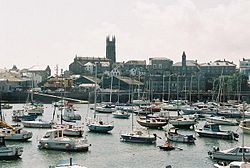 Penzance harbour | |
| Location | |
| Grid reference: | SW475306 |
| Location: | 50°7’8"N, 5°32’13"W |
| Data | |
| Population: | 21,168 (2001) |
| Post town: | Penzance |
| Postcode: | TR18 |
| Dialling code: | 01736 |
| Local Government | |
| Council: | Cornwall |
| Parliamentary constituency: |
St Ives |
| Website: | Penzance Town Council |
Penzance is a port town in western Cornwall; the most westerly major town in the county. Penzance is just 5½ miles from Lands End.
The town lies in the shelter of Mount's Bay facing south-east onto the English Channel. To the west lies the fishing port of Newlyn and to the east is a long stretch of shore, Longsands, separating Penzance from Marazion. The town's location gives it a temperate climate, warmer than most of the rest of Great Britain. It is a popular tourist destination, with beaches and within easy reach of the Lands End and the sites of the wild Penwith peninsula.
Penzance is also the port for sailing to the Isles of Scilly, and outside the town is also the heliport for Scilly.
Penzance was granted a number of Royal Charters from 1512 onwards and incorporated in 1614.[1]
Name
The name of Penzance (Pensans or "holy headland" in the Cornish language), is a reference to the location of the chapel of St Anthony which stood over a thousand years ago on the headland to the west of what became Penzance Harbour. Until the 1930s this history was also reflected in the choice of symbol for the town; the severed 'holy head' of St John the Baptist. It can still be seen on the civic regalia of the Mayor of Penzance and on several important landmarks in the town. The only remaining object from this chapel is a carved figure which is now largely eroded known as 'St Raffidy' which can be found in the churchyard of the parish church of Penzance, St Mary's, which stands near the original site of the chapel.
The town
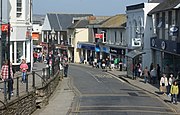
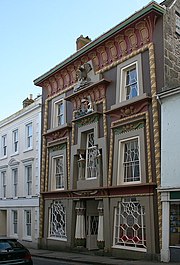
The main street of the town is Market Jew Street, its name from the Cornish language Marghas Yow, meaning Thursday Market, the name of the nearby village now named Marazion, to which Market Jew Street leads.[2] At the head of Market Jew Street is the neo-classical Market Hall and before it a statue of Sir Humphrey Davy. Along the street a great variety of shops, many catering for visitors and heading in to the maze of old streets in the heart of Penzance. Side streets continue the busy shopping area.
Wharf Road runs down along the seafront leading to the harbour and docks then at the Chimney Rocks it swings round as Battery Road becomes the Western Promenade below which is the beach.
Chapel Street and some of the delightful, narrow lanes of the town wander down from Market Jew Street to the quay and the promenade.
Penzance Regency and Georgian terraces and houses are common in some parts of the town.
Penzance's former main street, Chapel Street, has a number of interesting features, including the Egyptian House, The Union Hotel (including a Georgian theatre which is no longer in use) and The Branwell House, where the mother and aunt of the famous Brontë sisters once lived.
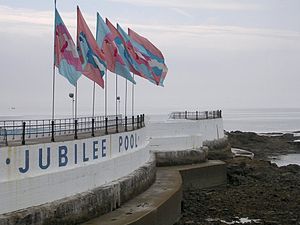
Also of interest is the seafront with its promenade and the open-air seawater Jubilee Bathing Pool (one of the oldest surviving Art Deco swimming baths in the country), built at the beginning of the 20th century during Penzance's heyday as a fashionable seaside resort. The pool was designed by Captain F Latham, the Penzance Borough Engineer and opened in 1935, the year of King George V's Silver Jubilee.[3] Penzance promenade itself has been destroyed in parts several times by storms. The most recent example was on 7 March 1962 (Ash Wednesday), when large parts of the western end of the promenade, the nearby Beford Bolitho Gardens (now a play park) and the village of Wherrytown suffered severe damage.[4]
Large sections of the Penzance Parish are classified as conservation areas under the Penwith local plan and are subject to special planning laws. The current conservation area forms most of the core of the town of Penzance and the historic harbour areas of Newlyn and Mousehole.[5]
A number of Georgian and Regency buildings are present in the town. However, the majority of developments in the town centre itself are of mixed date, including several 20th-century buildings, one of which, the former Pearl Assurance building (now a pub), was subject to comment by Sir John Betjeman who wrote, in 1963:
Penzance has done much to destroy its attractive character. The older houses in the narrow centre round the market hall have been pulled down and third-rate commercial 'contemporary', of which the Pearl Assurance building is a nasty example, are turning it into Slough.
The sub-tropical Morrab Gardens, has a large collection of tender trees and shrubs, many of which cannot be grown outdoors anywhere else in Britain.
Churches
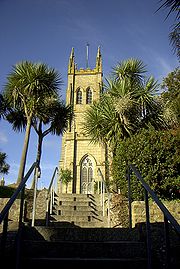
As in other Cornish towns, Methodism is the predominant Christian denomination. Before the 1980s Penzance had six Methodist churches, but this number has now been reduced to three, one of these in Newlyn.
- Church of England: [2]
- St Mary's (parish church) built in 1832–35
- St John's
- Methodist:
- Chapel Street Methodist Church [3]
- High Street Methodist Church
- Richmond Methodist Church
- Evangelical independent churches:
- Penzance Baptist Church [4]
- Shekinah Christian Church [www.shekinahchurch.co.uk/]
- Roman Catholic: Church of the Immaculate Conception
- Salvation Army: two citadels
Penzance was formerly in the parish of Madron. Two chapels are known to have existed before the Reformation.[6]
Around the town
Roads and paths lead out from Penzance. It is a fifteen-mile walk to Lands End around the coast path. Nearer to hand, the pretty fishing port of Newlyn is to the south, now contiguous with Penzance, and around the cliff is Mousehole from which paths lead up and over the hills. Madron, the little village from whose parish Penzance grew, is two miles to the north.
Marazion lies on the other end of Mounts Bay, punctuated by the tidal island of St Michael's Mount.
History
Evidence of Iron Age settlement can be found in Penzance in a number of sites, including Lescudjack Castle, an Iron Age hill fort and settlement within the current Penzance parish boundaries. The town howerever came later.
Middle Ages
Evidence of historical settlement from this period can be found in the St Clare area of the town, where a chapel not unlike St Anthony's existed dedicated to St Clare or Cleer. Throughout the period before Penzance gained borough status in 1614 the village and surrounding areas fell within the control of the Manor of Alverton and was subject to the taxes levied by that manor.
The first historical mention of Penzance was in 1322 in local manorial records where it is given as a place for landing fish.[7] Until the 17th century Penzance was overshadowed by its near-neighbour Marazion. Marazion was recorded in the Domesday Book of 1086 while Penzance is not, and Marazion received its charter much earlier, for King Henry III in 1257. In mediaeval times and later, Penzance was subject to frequent raiding by "Turkish pirates", in fact Barbary Corsairs.[8]
In 1404 King Henry IV granted to Thomas Lord Berkley the right to hold a market in Penzance. This was the first seed of the town's growth.
Tudor period
In 1512 King Henry VIII granted the town the right to charge harbour dues. At about this time and the harbour was constructed and the first pier was built in 1512.[9]
In the summer of 1578 Penzance was visited by the plague. The burial registers of Madron (within which parish the village then fell) shows a massive increase in deaths for 1578, from 12 the previous year to 155, estimated to be about 10% of the population of the village at the time. The plague returned in 1647 and the registers again show an increase of from 22 burials to 217 in one year.[10]
Being at the far west of Cornwall, Penzance and the surrounding villages have been vulnerable to attack from the sea and the town has been sacked by foreign fleets in times past. On 23 July 1595,[11] seven years after the Spanish Armada of 1588 was defeated, a Spanish fleet under Don Carlos de Amesquita landed troops in Cornwall. Amesquita's force seized supplies, raided and burned Penzance and surrounding villages, held a mass, and sailed away before it could be confronted.[12]
The town since 1614
Penzance's relative success came from its markets, drawing the produce of the surrounding villages here, and its place as a fishing port. In 1614 King James I granted it the status of a borough.
During the English Civil War, Penzance was sacked by the forces of Sir Thomas Fairfax apparently for the kindness shown to Lord Goring's and Lord Hopton's royalist troops during the conflict.[13]
Penzance borough council undertook several major projects, including the building of the Market House (which was the home of the Corn Exchange and the then Guildhall), The southern arm of the pier was built in 1766 and extended in 1785.[14]
Civic improvements in this period included the construction in 1759 of a reservoir which supplied water to public pumps in the streets.[15]
On 1 November 1755, the Lisbon earthquake struck, destroying that famous city. It also caused a vast wave which set forth across the western ocean and struck the Cornish coast, over 1,000 miles away from the epicentre. At around 2 o'clock in the afternoon, the sea rose eight feet in Penzance, came in at great speed, and ebbed at the same rate. Little damage was recorded.[16]
19th century
At the 1801 census, the town had a population of 2,248. The decennial census recorded a peak population in 1861 of 3,843, but it then declined, as in most of Cornwall, through the remainder of the century, being just 3,088 in 1901.[17]
The first lifeboat in Cornwall was bought by the people of Penzance in 1803 but it was sold in 1812 due to lack of funds to keep it in operation.[18]
The Royal Geological Society of Cornwall was founded in the town in 1814[19] and about 1817 was responsible for introducing a miner's safety tamping bar, which attracted the Prince Regent to become its patron.
The pier had been extended again in 1812 and John Matthews opened a small dry dock in 1814, the first in the South West. In 1840 Nicholas Holman of St Just opened a branch of his foundry business on the quayside. These facilities proved valuable in supporting the steamships that were soon calling at the harbour in increasing numbers.
By the time Queen Victoria came to the throne in 1837, Penzance had established itself as an important regional centre.
Gas lighting was introduced in 1830 and the old Market House was demolished in 1836. Its replacement, designed by W. Harris of Bristol, was completed at the top of Market Jew Street in 1838. St Mary's Church, another prominent feature of the Penzance skyline, was completed in 1836, while a Roman Catholic church was built in 1843. Another familiar building from this period is the eccentric Egyptian House in Chapel Street, built in 1830. The first part of the Promenade along the sea front dates from 1844.
Penzance was one of the first towns to petition to form a local board of health following the passing of the Public Health Act 1848 and the Board was established in 1849, setting forth to build many facilities to enhance public health. A report of the time shows that most streets were macadamised or paved, and the town was lit by 121 gas lamps from October to March each year except during a full moon. Water came from 6 public pumps, and there were a further 53 private wells. There were no sewage pipes at the time, waste being collected from the main streets by a refuse cart.
In 1871 the Bishop of Exeter created Penzance a parish in its own right, taking it out of the local parish of Madron to which it had belonged since the Middle Ages. Madron Church was in fact the centre of most religious activity in the town until 1871. In this year St Mary's Church was raised from being a chapel of ease into a parish church.
The railway came in 1852, Penzance serving as the terminus of the West Cornwall Railway. It did not link as far as Plymouth until 4 May 1859. Through passenger trains to London ran from 1 March 1867. The railway connected the foarmers and fishermen of western Cornwall to the ider markets and brought a new prosperity to distant Penzance. It also brought tourists to enjoy the mild climate of Penzance. Bathing machines had been advertised for hire on the beach as early as 1823,[20] and the town was already "noted for the pleasantness of its situation, the salubrity of its air, and the beauty of its natives".[21] The town's first official guide book was published in 1860 and the Queen's Hotel opened on the sea front the following year. It was so successful that it was extended in 1871 and 1908.
The original station was rebuilt with the present buildings and train shed over the platforms (1880). The lower end of Market Jew Street was widened and a new road was built to link the station with the harbour over the Ross Swing Bridge (1881), allowing the construction of proper sewers beneath. A larger dry dock replaced Matthews' original facility (1880), and a floating harbour was made (1884) with Lock (water transport)|lock gates to keep in the water at low tide.
Around the headland, public baths were opened on the Promenade in 1887 and the Morrab Gardens with its sub-tropical plants was opened two years later. A bandstand was added to the gardens in 1897.>
20th century
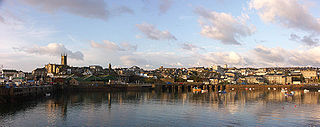
Tourist development marked the opening of the twentieth century. New facilities and new hotels were springing up. The Great Western Railway introduced the Cornish Riviera Express on 1 July 1904, which left London Paddington at 10:10 and arrived in Penzance just 7 hours later, two hours faster than the previous quickest service. The railway promoted local tourism with postcards that were sold at its stations, and an annual guide book, The Cornish Riviera, in which Petre Mais described the town as "a suburb of Covent Garden, and a great fishing centre ... there is always something going on in its harbour".[22] In 1923 a new road link opened tp the harbour area and the Promenade, and in 1933 the St Anthony Gardens were built, followed two years later by the Jubilee Bathing Pool opposite. Tourists could now make full use of the whole seafront between Penzance and Newlyn harbours.
A new extension to the station was built in the 1930s on reclaimed land beneat Chyandour Cliff to cope with the increasing numbers of tourists.
New workshops were built during the 1930s, and the docks were used by the Isles of Scilly ferries and other merchant ships, as well as Trinity House, the Royal Navy and Royal Maritime Auxiliary Service. In 1951 a new vessel for the King Harry Ferry on the River Fal was launched, built on the keel of an old landing craft. A steam tug, the Primrose, was built in 1963.
Mining
The Penzance Mining and Science School was founded in 1890. The school continued to teach mining until 1910, when it was amalgamated with Camborne and Redruth Mining School forming the School of Metalliferous Mining in Camborne, which is now known as the Camborne School of Mines. This institution has now moved to the Combined Universities in Cornwall campus at Tremough, Falmouth.
From 1663, Penzance was a coinage town, responsible for the collection of tin taxation on behalf of the Duchy of Cornwall and it held this status for 176 years.[23] According to William Pryce in his 1778 book Mineralogia Cornubiensis, Penzance coined more tin than the towns of Liskeard, Lostwithiel, and Helston put together. Penzance also had a mine running out beneath the sea, situated off the coast of the town next to the area known as Wherrytown. The mine, known as Wheal Wherry, was worked from 1778 to 1798 and again from 1836 to 1840.[24] Founded by "a poor 57 year old miner" named Thomas Curtis, the mine was said to be "very rich at depth" and was connected to the shore by a wooden bridge; the ore was transported by wherry boat. The mine suffered considerable damage in 1798 when an American ship broke anchor off nearby Newlyn and smashed into the bridge and head gear. Later attempts at mining were not as profitable.[25]
During the 19th century and until 1912, Penzance had the largest tin smelting house in Cornwall, operated by the Bolitho family. The smelting works were situated at Chyandour.[26] As a consequence of this concentration of mining wealth, Penzance became a centre for commercial banking. The Bolitho Bank (now part of Barclays Bank)[27] and the Penzance Bank were two of the largest in their time.
Culture
Festivals
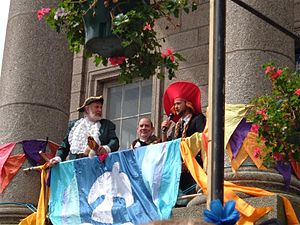
Every June since 1991, the Golowan Festival (which includes Mazey Day) has been held in the town.
Before the 1930s Penzance was the scene of large May Day celebrations, which saw local children making and using tin 'May horns' and 'May whistles'; a small revival of these traditions took place by design on 4 May 2008. The Feast Day of Corpus Christi was also celebrated in Penzance. The Corpus Christi fair has been a long-standing event in the town, and is currently undergoing attempts to revive it in a more traditional format.
Allantide, a Cornish version of Halloween, was also a popular activity in the town. Many of these customs were recorded by local antiquarian Margaret Ann Courtney and have influenced historical views of traditional Cornish cultural activities.
In October 2010 the first full festival of music and the arts, the Penzance Proms, was held.
Every December Penzance holds the Montol Festival a community arts event reviving many of the Cornish customs of Christmas, including Guise dancing.
Music and theatre
Penzance is the home of the pirates in Gilbert and Sullivan's comic opera, The Pirates of Penzance. At the time the libretto was written, 1879, Penzance had become popular as a peaceful resort town, so the very idea of it being overrun by pirates was amusing.
Until 2010 Penzance was home to the Acorn Theatre sited within a former Methodist chapel. The town also had a music hall; the Victoria Hall Music Hall. This is now the Savoy, an independent cinema and reputedly the oldest continuously used cinema in Britain.
Art galleries
Penzance is home to the new Newlyn Art Gallery establishment "The Exchange" which opened in 2007. Penzance is also the home of Penlee House, an art gallery and museum notable for its collection of paintings by members of the Newlyn School. Within Penzance town centre there are a growing number of commercial art galleries.
Sir Humphry Davy
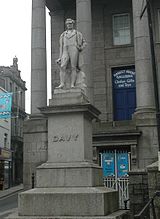
Penzance was the birthplace of the famous chemist Sir Humphry Davy. Davy was President of the Royal Society and invented the process of electrolysis, was the first person to isolate sodium, was the first person to discover laughing gas, as well as proving (with Michael Faraday) that diamonds are made of pure carbon. Today he is possibly best known as the inventor of the Miner's Safety Lamp, or Davy Lamp. There is a statue of Davy at the top of Market Jew Street, near the house in which he was born. One of Penzance's secondary schools is also named after the scientist, and runs as a music and maths community college. Robert Dunkin, a Penzance sadler and maker of scientific instruments, taught Davy the basis of practical science.
Outside links
- Penzance Town Council
- Cornwall Record Office Online Catalogue for Penzance
- Mount's Bay Pilot Gig Rowing Club
References
- ↑ Penzance Charter of Incorporation dated 9 May 1614, held by Penzance Town Council
- ↑ O.J. Padel (1988). A Popular History of Cornish Place-Names. Alison Hodge.
- ↑ Janet Smith; Liquid Assets - the lidos and open air swimming pools of Britain ISBN 0-9547445-0-0
- ↑ History of the town and Borough of Penzance
- ↑ List of Penwith conservation areas from Penwith Council Website
- ↑ Cornish Church Guide (1925) Truro: Blackford; pp. 177-178
- ↑ Extent of the property held by the Manor of Alverton and accounts transcribed by Mr Paul Brand from the original held in the National Archives
- ↑ Canon Diggens Archive 1910
- ↑ Guthrie, A. (1994). Cornwall in the Age of Steam. Padstow: Tabb House. ISBN 1-873951-16-7.
- ↑ Notes on the Madron Parish Registers -Canon Jennings
- ↑ Trelease, G. M. A History of the Church in Paul Parish
- ↑ A detailed description of the Spanish raid of 1595 can be found here
- ↑ Lewis, Samuel (1831) Topographical Dictionary of England
- ↑ Kittridge, Alan (1989). Cornwall's Maritime Heritage. Truro: Twelveheads Press. ISBN 0-906294-15-0.
- ↑ Bennett, Alan (1987). Cornwall Through the Mid 19th Century. Southampton: Kingfisher Railway Publications. ISBN 0-946184-26-7.
- ↑ [1] Sources of Cornish History - The Lisbon Earthquake
- ↑ UK & Ireland Genealogogy - Penzance
- ↑ Leach, Nicholas (2006) [2000]. Cornwall's Lifeboat Heritage. Chacewater: Twelveheads Press. pp. 41. ISBN 0-906294-43-6.
- ↑ Murray's Handbook of Devon and Cornwall. London: John Murray. 1859.
- ↑ Guthrie, A. (1994). Cornwall in the Age of Steam. Padstow: Tabb House. ISBN 1-873951-16-7.
- ↑ Stockdale, F. W. L. (1824). Excursions in the County of Cornwall. London: Simpkin and Marshall. (Reprinted by D Bradford Barton, Truro, 1972)
- ↑ Mais, SPB (1928). The Cornish Riviera. London: Great Western Railway (3rd Edition 1934).
- ↑ PAS Pool History of the Borough and Town of Penzance 1974 page 74
- ↑ Mines and Miners Of Cornwall Vol 4. pages 17-21
- ↑ Mindat.org mine information
- ↑ PAS Pool history of the town and Borough of Penzance 1974
- ↑ Company History Barclays PLC Website